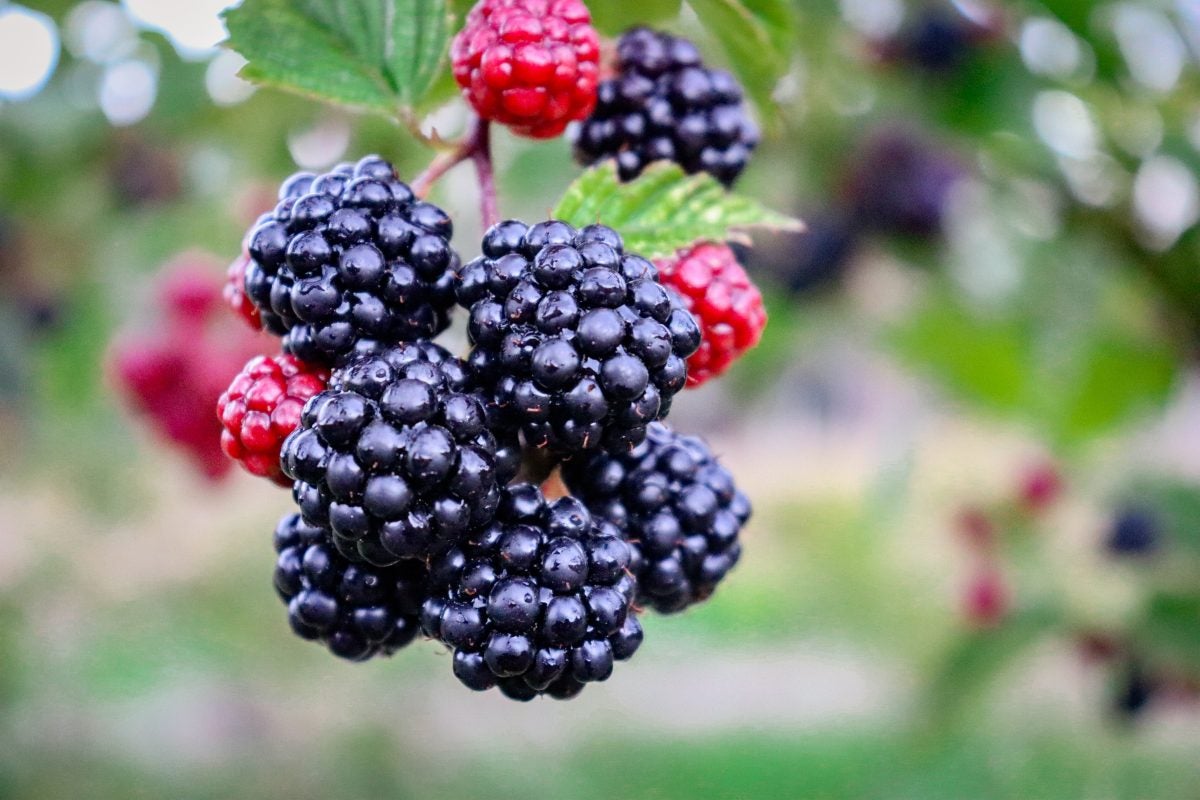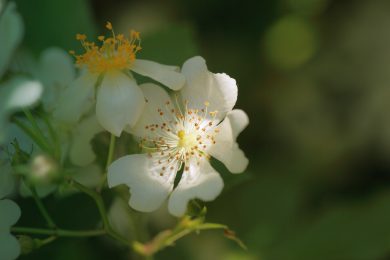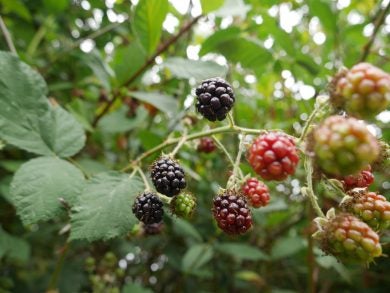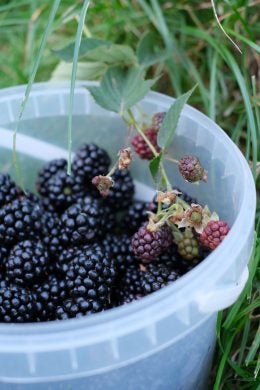Dark and Sweet – Your guide to Wild Blackberries
Megan Plete Postol 05.20.21

Plump and juicy wild blackberries are a favorite for many foragers. The fleshy berries can be used in desserts, jams, wine, salads, and in a variety of other recipes. My personal favorite way to eat wild blackberries is with milk, in a bowl, the way you would eat cereal in the morning. If they taste tart in the milk, sprinkle a little bit of sugar on top, and voila! Breakfast is served. Blackberries are often mixed with apples in baking which provides a nice balance for pies and crumbles.
Blackberries grow in clusters of thorny shrubs called brambles. Unmanaged mature plants form a prickly tangle of dense arching stems. The stems are covered in short, sharp prickles. Because of the prickles, it is important to dress appropriately when picking blackberries. Long sleeves, pants, boots, and a hat or ballcap should provide adequate protection from prickle scratches while harvesting blackberries.
Each blackberry bush, or bramble, is a collection of several canes. Canes are the flexible anchor of the berry bush. New canes are continually produced, resulting in dense patches. Blackberries are a perennial plant meaning they grow back year after year. First year canes typically grow to a length of three to nine feet, but do not flower and; therefore, do not produce fruit. Second year canes typically can start producing buds and then berries.

Blackberry bushes multiply rapidly from year to year and can take over an area very quickly. These patches of wild blackberry brambles can be found along wooded tree lines, on the edges of farm fields, and on overgrown fencerows. They also show up in vacant lots, hillsides, and ditches. They tolerate poor soil conditions and can thrive almost anywhere.
In the spring, blackberry brambles can be identified by the numerous small white flowers with a greenish-yellow center bud, surrounded by many pinkish-colored stamens that will eventually give way to the berries. The flowers will have five soft white petals. Each cane can have multiple flowering buds and the flowers will bloom in clusters. At their widest, blackberry flowers will measures 1 – 2″ across.
As the summer progresses, small green berries will emerge. The berries will develop in color from green to pink to red, and finally to a deep purplish-black when they have reached maturity. You’ll know the berry is ready to be picked if it easily pops off the branch. Immature berries will be more difficult to pick, as they will continue to adhere and it will feel like you’re trying to break it off rather than it sliding off smoothly.

In the United States there are several different species of blackberries that grow in the wild. Mature blackberries, like their raspberry cousins, are thankfully fairly easy to identify, without any poisonous doppelgangers, so the risk of making a dangerous identification mistake is quite low. They will appear black when ripe, can vary in size from approximately the size of your pinkie fingertip to your thumb tip, and are characterized by their bumpy shape.
Wild blackberries and wild raspberries are commonly confused because there are varieties of wild that turn black when ripened. Although mistaking the two is not harmful, it can be helpful to know how to tell these two berry varieties apart. The difference lies within the center of the berry. What distinguishes the two is whether or not the torus (receptacle or stem) stays inside the fruit or remains on the stem when picked. Blackberries are solid, right up to the stem. When picking a blackberry, the torus stays with the fruit, comes off of the stem and the berry comes off intact. When picking a raspberry, the torus remains on the plant, leaving a hollow core in the cup-shaped raspberry.
Blackberries, like most berries, are good for our health. Healthline reports that one cup of raw blackberries has 30.2 milligrams of vitamin C. That’s half the daily recommended value. Vitamin C is integral to collagen formation in bones, connective tissue, and blood vessels. The fresh berries are also full of other vitamins and minerals, including vitamin K and manganese, and are high in fiber. Blackberry seeds contain oil rich in omega-3 (alpha-linolenic acid) and omega-6 (linoleic acid) fats as well as protein, dietary fiber, carotenoids, ellagitannins, and ellagic acid.
The powerhouse blackberry is a favorite food source for animals, too. Birds, snakes, fox, and bear (and other wildlife) love them, and that’s why it is important to be aware of your surroundings while picking blackberries. It’s a good idea to pick with a friend and to make some noise while you’re picking. Making noise lets animals know that you are in the area. Being too quite could cause some unwelcome encounters. Accidently startling a mama bear while you’re trapped in the middle of six-foot-tall thorn covered brambles isn’t going to make for the best day ever.

There are many ways to consume wild blackberries. After picking, wash them thoroughly to remove insects and debris. Separate any leaves or stems that collected with the berries. The berry can be eaten raw or cooked. They can also be frozen to unthaw and bake with later in the year. Here’s a quick an easy recipe to try:
Blackberries & Spinach Salad
- 3 cups baby spinach, rinsed and dried
- 1 cup fresh blackberries
- 6 ounces crumbled feta cheese
- 1 pint cherry tomatoes, halved
- 1 green onion, sliced
- ¼ cup finely chopped walnuts or almonds (Optional)
*In a large bowl, toss together baby spinach, blackberries, feta cheese, cherry tomatoes, green onion, and nuts.
More blackberry recipes can be found here.
For further information and for reference when identifying berries, check out “The Forager’s Harvest,” by Samuel Thayer, “Identifying and Harvesting Edible and Medicinal Plants in Wild (and Not So Wild) Places,” by Steve Brill or “Field Guide to Edible Wild Plants: Eastern and Central North America,” by Lee Allen Peterson and Roger Tory Peterson. When in doubt, consult a guidebook. Note: This guide is not exhaustive and please do not consume any wild berry that you are not 100% sure about.